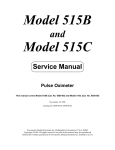Download q0420 phase-locked oscillator (plo) evaluation system
Transcript
Q0420 PHASE-LOCKED OSCILLATOR (PLO) EVALUATION SYSTEM USER’S GUIDE INTRODUCTION The Q0420 PLO Evaluation System is a complete evaluation board designed on a compact 5” x 7.5” printed circuit card for the Q3236 PLL. The evaluation platform includes a fixed demonstration as well as a custom prototyping design. A block diagram of the Q0420 is shown in Figure 1. The Q0420 demonstration platform consists of a phase-locked oscillator system which generates frequencies from 2 GHz to 3 GHz with a minimum step size of 5 MHz over the full output frequency range (÷ 2 prescaler included on-board). The custom prototyping option allows the designer to rapidly configure a custom synthesizer by adding a VCO, loop filter and reference suppression filter components to the alternative circuit sections of the board. The user can easily select between the demonstration platform and the custom prototyping design via on-board jumper options. Additional input and output connectors are also provided to easily support the use of off-board VCO’s and prescalers to quickly evaluate the performance tradeoffs between alternative components. The Q0420 can be computer controlled for remote operation, or alternatively controlled through the on-board frequency control switches for stand-alone operation. Remote operation is accomplished through the custom software program, Data I/O Card, and cabling provided with the Q0420 board. The menu-driven software will automatically compute all desired frequency programming and can exercise the following Q3236 modes of operation: • 16-bit Direct Parallel Control • 8-bit Data Ping-Pong Control • 8-bit Data Bus Control • 20-bit Serial Ping-Pong Control • 20-bit Serial Control Stand-alone operation with the Q0420 requires only a single +15VDC power supply, but can only utilize the Q3236’s direct parallel interface for frequency programming using on-board DIP switches. This User’s Guide provides all the information needed to use the Q0420 PLO Evaluation System. Appendices are also provided which contain the Q0420 schematics, layout and a complete parts list. When designing custom synthesizers using the Q0420, it is recommended that the designer also read QUALCOMM’s Q3236 Technical Data Sheet. It contains numerous design hints and discusses not only the electrical performance of the Q3236, but also has an application section that discusses how a PLL synthesizer can be designed. The Q0420 PLO Evaluation System is meant to be a demonstration circuit and evaluation tool. QUALCOMM does not make any warranty as to the Q0420’s suitability for a specific application without further design modifications. However, we believe you will find the Q0420 a useful system to further your understanding of synthesizer design with QUALCOMM’s integrated PLL devices. CONTENTS 1.0 3.3 GETTING STARTED ......................................... 3 Digital I/O Board Installation .................... 3 3.3.1 Reference Divider .......................... 18 1.2 Digital I/O Board Software 3.3.2 VCO Divider .................................. 18 Configuration .............................................. 3 1.3 Q0420 PLO Evaluation System Software 4.0 1.4 DESCRIPTION OF BOARD FEATURES ......... 20 4.1 Installation .................................................. 5 2.0 DIP Switch Settings .................................. 17 1.1 Q3236 Phase-Locked Loop Frequency Synthesizer ................................................ 20 Q0420 PLO Evaluation System Setup ....... 6 4.2 Reference Oscillator ................................. 20 SYNTHESIZER OPERATION ............................ 6 4.3 Line Receiver ............................................ 20 2.1 Inputs .......................................................... 6 4.4 Voltage Controlled Oscillator (VCO) ...... 20 2.1.1 Power Supply Requirements .......... 6 4.5 Loop Filter ................................................. 20 2.1.2 External Reference Input; (J1) ......... 6 4.6 Reference Suppression Filter .................... 21 2.1.3 External VCO Input; (J10) ............... 7 4.7 Prescaler .................................................... 21 2.1.4 Ping Pong Control In; (J10) ............. 7 2.2 Outputs ....................................................... 7 5.0 2.2.1 Synthesizer Out; (J9) ....................... 7 2.2.2 Ref. Div. Out; (J2) ............................ 7 2.2.3 VCO Div. Out; (J7) .......................... 7 2.2.4 Prescaler Out; (J8) ............................ 7 2.2.5 Ext. VCO Control; (J5) .................... 7 2.3 Jumper Settings ........................................... 8 2.3.1 Reference Frequency Jumpers ........ 8 2.3.2 Loop Filters ...................................... 9 2.3.3 Op Amp Negative Rail Voltage Selection .......................................... 9 2.3.4 Reference Suppression Filter ........ 10 2.3.5 VCO Selection ............................... 10 DESIGN HINTS AND SUGGESTIONS .......... 22 5.1 Power Supplies .......................................... 22 5.2 External Reference Source ....................... 22 5.3 Q0420 EMI Shield ..................................... 22 5.4 Phase Offset Trimpot ............................... 22 6.0 RELATED LITERATURE ................................. 22 7.0 APPENDIX ......................................................... 23 7.1 Appendix A: Q0420 Schematic Drawings ................................................... 24 7.2 Appendix B: Q0420 Parts List .................. 30 7.3 Appendix C: Q0420 layout Drawings ...... 32 QUALCOMM ASIC PRODUCTS ............................. 36 2.3.6 Prescaler ......................................... 12 2.3.7 Q3036 Mode .................................. 12 2.3.8 Ping Pong Mode External Control ........................................... 12 2.3.9 Test Points ..................................... 12 3.0 Q0420 FREQUENCY CONTROL .................... 13 3.1 Direct Parallel Mode, Eight Bit Bus Mode, Serial Mode ............................................... 14 3.1.1 Reference Frequency ..................... 14 3.1.2 Output Frequency ......................... 15 3.1.3 Phase Detector Frequency ............ 15 3.1.4 Divide by Two Prescaler ............... 15 3.1.5 PRE EN/ ......................................... 15 3.1.6 Quit ................................................ 15 3.2 Ping Pong Mode ........................................ 16 3.2.1 Output Frequency ......................... 17 2 QUALCOMM Incorporated, ASIC Products 6455 Lusk Boulevard, San Diego, CA 92121-2779, USA Q0420 Phase-Locked Oscillator (PLO) Evaluation System User’s Guide E-mail: [email protected] Telephone: (619) 658-5005 Fax: (619) 658-1556 Data Subject to ChangeWithout Notice 1.0 GETTING STARTED The Q0420 PLO Evaluation System requires the following computer hardware as a minimum to operate in Remote Mode: • PC 80386 or better • 4 MB RAM • Math Coprocessor • Hard Drive • Mouse • Windows™ Version 3.1 or better • SVGA Video Card (1024 X 768 resolution, small fonts) The Q0420 PLO Evaluation System consists of a Q0420 Evaluation Board, Q0420 Shield, Q0420 Control Software, Control Cable, Digital I/O (DIO) Board, and DIO Board Installation Software. In order to operate the Q0420 Evaluation Board in Remote Mode, the DIO Board needs to be installed in a PC. The DIO Driver Software and the Q0420 Control Software needs to be installed on the hard drive of the PC. To use the Q0420 in Stand-alone Mode, a PC is not required. Note: Windows™ is a trademark of Microsoft® Corporation. 1.1 DIGITAL I/O BOARD INSTALLATION Install the DIO Board in any open slot in your PC according to the CIO-DIO24 User’s Manual provided with the evaluation system. We recommend the base address of the CIO-DIO be set to 300H and the interrupt level set in the “X” position. Once the DIO Board is installed in your PC, the board needs to be configured with the Instacal software provided. Place the Instacal disk in your floppy drive, access the floppy drive (usually A:) and type “Install”. This can be accomplished in DOS or Windows. 1. The Computer Boards Software Installation title screen will appear once the Install.exe file is run. From this menu select “I”, Install, to proceed and complete installation. 2. Once the PCMCIA installation window appears, select “No”. Likewise, select “No” to the Universal Library and Labview Driver Installation Window. 3. Select the drive and directory you want the Instacal program to reside. We suggest using the default, C:\CB. The software will automatically copy all files from the disk into the specified directory on your hard drive. 4. Once all files are copied to your hard drive, the software will ask if you would like to have the AUTOEXEC.BAT file modified automatically, select “Yes”. The program will automatically add C:\CB to your path. 5. 1.2 After all files have been copied to your hard drive, reboot your computer to complete the installation process. DIGITAL I/O BOARD SOFTWARE CONFIGURATION Once the software installation is complete, it is necessary to configure the software to control the Digital I/O board. The following procedure will configure and test the DIO drivers to ensure that the software is communicating with the DIO board. 3 QUALCOMM Incorporated, ASIC Products 6455 Lusk Boulevard, San Diego, CA 92121-2779, USA Q0420 Phase-Locked Oscillator (PLO) Evaluation System User’s Guide E-mail: [email protected] Telephone: (619) 658-5005 Fax: (619) 658-1556 Data Subject to ChangeWithout Notice QUALCOMM Incorporated, ASIC Products 6455 Lusk Boulevard, San Diego, CA 92121-2779, USA Q0420 Phase-Locked Oscillator (PLO) Evaluation System User’s Guide Computer Interface +5V External Reference Input Optional Path Default Path DB37 40 MHz DIP Switch Control Status Line Receiver Line Receiver Lock Detect DIP Switch Q3236 VCO Divider Output Ping-Pong Control Input Line Receiver Prescaler Output Resistive Divider Reference Divider Output ÷2 Prescaler Loop Filter #2 Loop Filter #1 + 15 V + 15 V Reference Filter Synthesizer Output Resistive Divider Voltage Conversion and Conditioning +5V VCO #2 VCO #1 External VCO Control External VCO Input –5V Figure 1. Q0420 PLO Evaluation System Block Diagram 4 E-mail: [email protected] Telephone: (619) 658-5005 Fax: (619) 658-1556 Data Subject to ChangeWithout Notice 1. Once the software installation is complete, run Instacal.exe located in the drive and directory you chose during installation, most likely C:\CB. 2. From the Instacal Menu, double click your mouse on the “Install” pull down menu. 3. Double click your mouse on “Board #0”. 4. Select “Board type” and choose the “CIO-DIO24”. 5. Select the base address to match the address you selected via dip switches located on the CIO-DIO24 Board, most likely 300H. 6. Select the Interrupt Level to match the interrupt level you selected via the interrupt jumper located on the CIO-DIO24 Board, most likely none. 7. After the board is configured, it can be tested. To do this, double click your mouse on the “Test” pull down menu. 8. Select “Board #0 = CIO-DIO24”. WARNING BEFORE PROCEEDING TO THE NEXT STEP, REMOVE ALL EXTERNAL CONNECTIONS TO THE DIO BOARD 9. Select “Internal Test”, then “yes”. 10. The software will test the DIO Board checking the input and output registers. If the test is successful, you will receive a message that states “the DIO Board has been found and the registers have been written to and read back”. This completes the DIO installation process. If you receive an error message, recheck the jumper settings on the DIO Board and rerun the Instacal program Step 3 of Digital I/O Software Configuration. If you continue to receive an error message, contact Computer Boards Inc. 11. Exit from the Instacal program. 1.3 Q0420 PLO EVALUATION SYSTEM SOFTWARE INSTALLATION The following procedure describes the Q0420 Control Software installation process. 1. Insert the Q0420 Control Software into the floppy drive of your computer. 2. Access the floppy drive using the Windows file manager. 3. Double click your mouse on “Setup.exe”. 5 QUALCOMM Incorporated, ASIC Products 6455 Lusk Boulevard, San Diego, CA 92121-2779, USA Q0420 Phase-Locked Oscillator (PLO) Evaluation System User’s Guide E-mail: [email protected] Telephone: (619) 658-5005 Fax: (619) 658-1556 Data Subject to ChangeWithout Notice 4. The software will ask you where you want the files to be installed on your hard drive. The default is: C:\QUALCOMM\Q0420. The software will require approximately 3 MB of hard drive space. Select “Ok” to proceed. The software will copy and decompress all files onto your hard drive into the directory you selected. 5. Once all files have been written to your hard drive, the software will ask you if you want it to automatically create a Windows program group. The default program group name is “QUALCOMM”. If you select “Create”, the software will automatically create a program group and a program item for the Q0420 Control Software. If you select “skip”, the software will not create the program group and program item. 6. This completes the Q0420 Control Software installation process. Select “Ok”. 1.4 Q0420 PLO EVALUATION SYSTEM SETUP First, turn off the computer; connecting the Q0420 Control Cable while the PC is on may damage the PC. Connect the DIO Board located in the PC to the Q0420 Evaluation Board through the DB37 Control Cable provided. Turn on PC and run Windows. Before running the Q0420 Evaluation Board Software, ensure the dip switches S1 and S2 are set to the “off” or logical zero position. Operating the software while the dip switches are in the “1” or high position may damage the DIO Board. Execute the Q0420 Control Software from the QUALCOMM program group in Windows. 2.0 SYNTHESIZER OPERATION Figure 1 shows the Q0420 PLO Evaluation System block diagram. The following paragraphs describe the function and operation of each of the circuit elements shown in the block diagram. 2.1 INPUTS 2.1.1 POWER SUPPLY REQUIREMENTS A single +15 VDC ± 5% (500 mA capability) power supply is required to operate the Q0420. The +15VDC input is the red banana jack while ground is the black banana jack. The Q0420 converts and conditions the +15VDC input to +5VDC. A +15VDC to -5VDC voltage converter circuit is provided on the board for applications that require a negative rail be supplied to the op amp. The -5V regulation is a switching device and may cause spurious components on the output of the synthesizer. The -5V circuit is disabled when the board is shipped. Proper voltage input and conversion is indicated by the three yellow LED’s, DS1-DS3. 2.1.2 EXTERNAL REFERENCE INPUT; (J1) The External Reference Input allows the user to bypass the on-board 40 MHz reference oscillator. This input can be used to characterize the synthesizer output when using other reference sources. When the External Reference Input is used, the reference signal can be selected to be processed by the input line receiver or the reference signal can bypass the line receiver. Figure 2 illustrates the proper way to connect the on-board jumpers for various operating modes for the reference inputs. The nominal input to J1 is 0 to 100 MHz, -10 to +5 dBm for a 50 ohm source. If you choose to use an external reference, the power to the 40 MHz on-board reference should be disabled to minimize on-board oscillations. 6 QUALCOMM Incorporated, ASIC Products 6455 Lusk Boulevard, San Diego, CA 92121-2779, USA Q0420 Phase-Locked Oscillator (PLO) Evaluation System User’s Guide E-mail: [email protected] Telephone: (619) 658-5005 Fax: (619) 658-1556 Data Subject to ChangeWithout Notice 2.1.3 EXTERNAL VCO INPUT; (J10) The External VCO Input is provided as a means to input a signal directly into the differential VCO inputs to the Q3236. This is necessary when using an external VCO or for troubleshooting the synthesizer system. The nominal input to J10 is -10 dBm to +3 dBm. 2.1.4 PING PONG CONTROL IN; (J10) The Ping Pong Control Input is only used when operating the Q3236 in the Ping Pong Mode. The input is routed to either FSELS or FSELP depending on the jumper position of JP16 and resistors R87 and R88. This input allows an external CMOS compatible input to switch between the data in the primary registers and the secondary registers. When FSELS/FSELP is high, the synthesizer output frequency is obtained from the frequency word stored in the primary registers. Conversely, when FSELS/FSELP is low, the synthesizer output frequency is obtained from the frequency stored in the secondary registers. This input is ideal for creating a FSK modulator for slow data rates. 2.2 OUTPUTS 2.2.1 SYNTHESIZER OUT; (J9) The Synthesizer Out signal provides the 2000 - 3000 MHz output in 5.0 MHz steps when using the on-board 40 MHz reference and VCO. The output power ranges from 0 to +7 dBm. 2.2.2 REF. DIV. OUT; (J2) The Ref. Div. Out provides a test point to view the divided Input Reference signal to the Phase/Frequency Detector on the Q3236. This output can also be used along with the VCO Div. Out to drive an external Phase/ Frequency detector or other external circuitry, if desired. Refer to the Q3236 Technical Data Sheet for nominal output levels. 2.2.3 VCO DIV. OUT; (J7) The VCO Div. Out provides a test point to view the divided VCO input signal that is being input to the Phase/ Frequency Detector. This output can also be used along with Ref. Div. Out to drive an external Phase/Frequency detector or other external circuitry, if desired. Refer to the Q3236 Technical Data Sheet for nominal output levels. 2.2.4 PRESCALER OUT; (J8) The Prescaler Out provides a test point to view the VCO divide-by-two prescaler output signal, which is also routed to the Q3236 VCO input. The output power of this signal is -25 dBm ± 3 dBm. 2.2.5 EXT. VCO CONTROL; (J5) The Ext. VCO Control is provided for use with an external VCO. The Ext. VCO Control provides the tuning voltage to the external VCO. The external VCO output can be fed back to the PLL device via Ext. VCO Input. By using an external VCO, the Q0420 can generate frequencies from L-Band to Ku-Band or higher. When output frequencies exceed 3000 MHz, an external prescaler is necessary prior to the Ext. VCO Input. 7 QUALCOMM Incorporated, ASIC Products 6455 Lusk Boulevard, San Diego, CA 92121-2779, USA Q0420 Phase-Locked Oscillator (PLO) Evaluation System User’s Guide E-mail: [email protected] Telephone: (619) 658-5005 Fax: (619) 658-1556 Data Subject to ChangeWithout Notice 2.3 JUMPER SETTINGS The Q0420 Evaluation Board has several jumpers which allow the option of choosing multiple configurations. The evaluation board is shipped with jumpers in default positions. The default jumper positions are listed in Table 1. Table 1. Default Jumper Positions 2.3.1 JUMPER POSITION JUMPER POSITION JUMPER POSITION JUMPER POSITION JP1 JP2 JP3 JP4 1 and 2 2 and 3 2 and 3 1 and 2 JP5 JP6 JP7 JP8 1 and 2 1 and 2 2 and 3 2 and 3 JP9 JP10 JP11 JP12 1 and 2 1 and 2 1 and 2 1 and 2 JP13 JP14 JP15 JP16 2 and 3 1 and 2 1 and 2 1 and 2 REFERENCE FREQUENCY JUMPERS There are three possible configurations for the reference jumpers, see Figure 2 and Table 2. We suggest using the line receiver for frequencies under 40 MHz. Configuration 1: Use the 40 MHz on-board reference. Use the supplied bi-pin jumpers and connect JP6 pin 1 and 2, JP2 pin 2 and 3, JP8 pin 2 and 3. Configuration 2: Use the Ext. Ref. Input and select the line receiver. Use the supplied bi-pin jumpers and connect JP1 pin 2 and 3, JP2 pin 1 and 2, JP8 pin 2 and 3. When not using the on-board reference, connect JP16 pin 2 and 3. This will power-down the on-board 40 MHz reference and decrease extraneous signal generation. Configuration 3: Use the Ext. Ref. Input and bypass the line receivers. Use the supplied bi-jumpers and connect JP1 pin 1 and 2, JP8 pin 1 and 2. When not using the on-board reference, connect JP6 pin 2 and 3. This will power-down the on-board 40 MHz reference and decrease extraneous signal generation. Figure 2. Reference Jumpers JP2 External Reference Input 1 1 2 3 Line Receiver 1 2 2 Line Receiver 3 3 JP1 +5 VDC To Q3236 Reference Input JP8 1 2 3 40 MHz Reference Line Receiver JP6 Table 2. Reference Selection REFERENCE SELECTION JP6 On Board Reference External Reference with Line Receiver External Reference without Line Receiver 1,2 2,3 2,3 JP1 – 2,3 1,2 JP2 JP8 2,3 1,2 – 2,3 2,3 1,2 8 QUALCOMM Incorporated, ASIC Products 6455 Lusk Boulevard, San Diego, CA 92121-2779, USA Q0420 Phase-Locked Oscillator (PLO) Evaluation System User’s Guide E-mail: [email protected] Telephone: (619) 658-5005 Fax: (619) 658-1556 Data Subject to ChangeWithout Notice 2.3.2 LOOP FILTERS Two loop filters are provided on the Q0420 Evaluation Board. The first loop filter is a second order filter which is populated and optimized for 100 kHz closed loop bandwidth for frequency operation between 2000 - 3000 MHz. The second loop filter can be configured as a second order or third order loop filter. This loop is not populated and is provided to the user for prototyping purposes. In order to select the first loop filter, connect jumpers JP10 pin 1 and 2, JP11 pin 1 and 2, and JP14 pin 1 and 2. In order to select the second unpopulated loop filter, connect jumpers JP10 pin 2 and 3, JP11 pin 2 and 3, and JP14 pin 2 and 3. See Figure 3 and Table 3. Figure 3. Loop Filter Selection Jumpers Loop Filter #1 1 2 PD_D -5V 1 3 2 3 VT 3 JP13 1 JP14 2 PD_U 1 2 JP10 Loop Filter #2 3 JP11 -5V 1 2 3 JP3 Table 3. Loop Filter Select LOOP FILTER SELECT Loop #1 Loop #2 2.3.3 JP10 JP11 JP14 1,2 2,3 1,2 2,3 1,2 2,3 OP AMP NEGATIVE RAIL VOLTAGE SELECTION The negative rail of the LT1357 OP Amp can be set to either ground or -5 volts. In order to set the negative rail of the op amp to -5 volts on the first loop filter, connect JP13 pins 1 and 2. To set the negative rail to ground, connect pins 2 and 3. Connect JP3 pins 1 and 2 to select -5 volts on the second loop filter or pins 2 and 3 for ground. See Figure 3, Table 4 and Table 5. Table 4. Negative OP Amp Rail Selection Loop #1 Table 5. Negative OP Amp Rail Selection Loop #2 NEGATIVE RAIL SELECTION LOOP #1 JP13 NEGATIVE RAIL SELECTION LOOP #2 JP3 -5V GND 1,2 2,3 -5V GND 1,2 2,3 9 QUALCOMM Incorporated, ASIC Products 6455 Lusk Boulevard, San Diego, CA 92121-2779, USA Q0420 Phase-Locked Oscillator (PLO) Evaluation System User’s Guide E-mail: [email protected] Telephone: (619) 658-5005 Fax: (619) 658-1556 Data Subject to ChangeWithout Notice 2.3.4 REFERENCE SUPPRESSION FILTER A reference suppression filter is provided on the board to attenuate the phase/frequency detector error pulses at the rate FPD. The reference suppression filter was optimized for 2.5 MHz and may need to be redesigned for different phase detector frequencies. In order to use the reference suppression filter, connect JP15 pins 1 and 2, and JP4 pins 1 and 2. If the user does not want to utilize the filter, connect JP15 pins 2 and 3, and JP4 pins 2 and 3. See Figure 4 and Table 6. Figure 4. Reference Suppression Filter Jumpers Table 6. Reference Filter Select Reference Suppression Filter 1 VT REFERENCE FILTER SELECT JP15 JP4 2 VCO VT 2 3 1,2 2,3 3 JP15 2.3.5 1,2 2,3 IN Bypass 1 JP4 VCO SELECTION The evaluation board can accommodate two VCO’s or utilize an external VCO. The board is shipped with a 2000 -3000 MHz VCO, U7, already installed. The user can install a different VCO, U8, or route the tune voltage off the evaluation board to an external VCO. Once the VCO is properly installed, the voltage tune path and the VCO output path needs to be configured. Figure 5, Table 7 and Table 8 show the VCO voltage tune paths and the VCO RF output paths. Figure 5. VCO Selection Jumpers + 5V + 15V R30 0 JP9 R31 0 1 VCO Power Conditioning PWR VT VCO #1 2 3 U7 1 VT VCO 2 R23 0Ω R69 0Ω R86 0Ω U8 3 R82 0Ω PWR VCO VT #2 JP5 VCO OUT External VCO Input External VCO Control Table 7. VCO Select Table 8. VCO Power VCO SELECT JP5 R23 R69 R86 R82 VCO #1 VCO #2 External VCO 1,2 2,3 Open OUT OUT IN IN OUT OUT OUT OUT IN OUT IN OUT VCO POWER +5V + 15 V VCO #1 VCO #2 R30 R31 IN OUT – – OUT IN – – JP9 – – 1,2 2,3 10 QUALCOMM Incorporated, ASIC Products 6455 Lusk Boulevard, San Diego, CA 92121-2779, USA Q0420 Phase-Locked Oscillator (PLO) Evaluation System User’s Guide E-mail: [email protected] Telephone: (619) 658-5005 Fax: (619) 658-1556 Data Subject to ChangeWithout Notice Configuration 1: Default VCO, U7. Connect JP5 pins 1 and 2 to route the tune voltage to the default VCO. R23, the zero ohm resistor, should be removed for optimum performance. Install R69, a zero ohm resistor, and remove R82 and R86 to select the correct RF output path. Configuration 2: Second VCO, U8. Connect JP5 pins 2 and 3 to route the tune voltage to the second VCO, U8. R23, the zero ohm resistor, should be removed for optimum performance. Install R82, a zero ohm resistor, and remove R69 and R86 to select the correct RF output path. Also, an AC coupling capacitor, C95, needs to be installed. This capacitor is not provided. The capacitor value selected should be optimized for the frequency output of the VCO. Configuration 3: External VCO. Remove the jumper on JP6 and install a zero ohm resistor in R23 to route the tune voltage to an external VCO. The external VCO tune voltage will be present on J5, a BNC connector. Install R86, a zero ohm resistor, and remove R69 and R82. Also, an AC coupling capacitor, C94, needs to be installed. This capacitor is not provided. The capacitor value selected should be optimized for the frequency output of the VCO. Fifteen volts or five volts can be routed to the power pin of either VCO depending on the operating voltage of the user’s VCO. Installing R31, a zero Ohm resistor, routes +15 volts to jumper J9. When R30 is installed, +5V is routed to J9. See Table 8. CAUTION: R30 and R31 cannot be installed at the same time. Damage may occur to the board if this happens. As stated above, the Q0420 can accommodate two VCO’s. Each VCO pad can accept two types of VCO footprints, either a standard 0.81” square pin-type package or a standard 0.91” square surface mount package. In order to accommodate the two VCO footprints, the tune voltage, supply voltage and VCO output are routed through 0Ω resistors. The Q0420 is manufactured with the resistors configured for the pin-type VCO’s. If the user would like to use a surface mount VCO footprint, the 0Ω resistors need to be configured according to Figure 6. Figure 6. VCO Pad Configuration VCO Supply Voltage VCO Supply Voltage VCO Tune Voltage VCO Tune Voltage R39 R62 VT R38 R63 VT +V R66 VT U7 U7 VCO #1 Pin-Type Footprint R41 VCO #1 Surface Mount Footprint R40 VT U8 VCO #2 Pin-Type Footprint +V R67 U8 +V VCO #2 Surface Mount Footprint VCO Output VCO Output VCO Output VCO Output R60 R61 R64 R65 VCO Output +V VCO Output 11 QUALCOMM Incorporated, ASIC Products 6455 Lusk Boulevard, San Diego, CA 92121-2779, USA Q0420 Phase-Locked Oscillator (PLO) Evaluation System User’s Guide E-mail: [email protected] Telephone: (619) 658-5005 Fax: (619) 658-1556 Data Subject to ChangeWithout Notice 2.3.6 PRESCALER A divide-by-two prescaler is provided in the VCO feedback path on the evaluation board as shown in Figure 7 and Table 9. This allows the Q3236 to synthesize frequencies above 2.0 GHz. The prescaler can be used in the feedback path to the Q3236 or it can be bypassed. Install zero ohm resistors in R78 and R75, and remove resistors R85 and R84 to utilize the prescaler. In order to bypass the prescaler, remove resistors R78 and R75, and install zero ohm resistors in R85 and R84. Figure 7. Prescaler Select Jumpers R78 0Ω R75 0Ω ÷2 Prescaler R85 0Ω R84 0Ω Table 9. Prescaler Select ÷2 PRESCALER SELECT R78 R75 R85 R84 MODE SELECT JUMPERS JP7 Connection IN OUT IN OUT OUT IN OUT IN Enhanced Mode (Access to M7, M8, R4, R5) Q3036 Mode/ Pins 1 and 2 Pins 2 and 3 IN Bypass 2.3.7 Table 10. Mode Select Q3036 MODE The Q3236 is pin-for-pin compatible with the Q3036 PLL and can be used as a direct replacement. Pin 44 of the Q3236 must be pulled “low” to operate in the Q3036 mode. Connect pins 2 and 3 of JP7 to pull pin 44 “low”. To use the Q3236 in Normal Mode and have access to the upper M and A counter bits, connect JP7 pins 1 and 2, which pulls pin 44 “high”, see Table 10. 2.3.8 PING PONG MODE EXTERNAL CONTROL When operating the Q0420 in Ping Pong Mode, the output frequency register selected can be controlled either through the control software or through the external Ping Pong Control In, Connector J6. If you are using the software to control which frequency register is selected, then the Q0420 does not need to be modified. To use the External Ping Pong Control Input to control frequency selection, then board modifications are required. If using Eight Bit Bus Ping Pong Mode, connect pins 2 and 3 of J16 and remove R88. This will route the input on J6 to the FSELP pin on the Q3236 and will disable the software from controlling the FSELP pin. If using Serial Bus Ping Pong Mode, connect pins 1 and 2 of JP16 and remove R87. This will route the input of J6 to the FSELS pin on the Q3236 and will disable the software from controlling the FSELS pin. 2.3.9 TEST POINTS Test points are located throughout the evaluation board for your convenience during testing and evaluation. Refer to the schematic in Appendix A for test points. 12 QUALCOMM Incorporated, ASIC Products 6455 Lusk Boulevard, San Diego, CA 92121-2779, USA Q0420 Phase-Locked Oscillator (PLO) Evaluation System User’s Guide E-mail: [email protected] Telephone: (619) 658-5005 Fax: (619) 658-1556 Data Subject to ChangeWithout Notice 3.0 Q0420 FREQUENCY CONTROL The frequency of the Q0420 can either be controlled through software and the Digital I/O Board or by setting the DIP Switches. The software that is provided with the Q0420 Evaluation Board allows the user to program the Q3236 in each of the five programming modes: Direct Parallel, Eight Bit Bus, Serial Bus, Ping Pong Eight Bit Bus, Ping Pong Serial Bus. The control software calculates the value of the M,A, and R counters and programs the Q3236. Before executing the Q0420 Control Software, make sure all DIP switches S1 and S2 are set to “0”. From Windows, double click on the Q0420 Control Software icon to execute the software. The window shown in Figure 8 will appear. If this window or subsequent windows do not fit on your monitor, then your video driver needs to be changed. For optimum performance, choose a video driver that supports a resolution of 1024 by 768 and at least 256 colors. You may move or resize the window as required. Choose the method in which you want to program the Q3236 by selecting the programming method and then selecting the execute button. One of five programming windows will appear. The window for Direct Parallel Mode, Eight Bit Bus Mode, and Serial Mode look the same but the programming of the Q3236 is carried out differently. Likewise, the Ping Pong Eight Bit Bus Mode and the Ping Pong Serial Mode front panels look the same but the programming of the Q3236 is carried out differently. Figure 8. Programming Mode Selection Software Screen Programming Mode Selection Direct Parallel Mode Execute Eight Bit Bus Mode Serial Bus Mode Ping Pong, Eight Bit Bus Mode QUALCOMM Q0420 EVALUATION BOARD SOFTWARE VER. 1.0 Ping Pong, Serial Bus Mode 13 QUALCOMM Incorporated, ASIC Products 6455 Lusk Boulevard, San Diego, CA 92121-2779, USA Q0420 Phase-Locked Oscillator (PLO) Evaluation System User’s Guide E-mail: [email protected] Telephone: (619) 658-5005 Fax: (619) 658-1556 Data Subject to ChangeWithout Notice 3.1 DIRECT PARALLEL MODE, EIGHT BIT BUS MODE, SERIAL MODE When either Direct Parallel Mode, Eight Bit Bus Mode, or Serial Bus Mode is selected from the Programming Mode Selection Menu (Figure 8), the window shown in Figure 9 will appear. The software will ask you if you want to go through the jumper setting windows. If you are a first time user of the evaluation board, it is suggested that you go through the jumper setting windows. You may also choose to bypass the jumper setting windows. The programming window shown in Figure 9 represents a block diagram of a phase-locked loop. The user has control of the Reference Frequency, Output Frequency, Phase Detector Frequency, Divide-by-Two Prescaler, PRE EN/ and QUIT. The Reference Divide, VCO Divide, R Value, M Value, A Value, R is not an Integer, R out of Range, and N is not an Integer are calculated from the inputs selected by the user. These values are then programmed into the Q3236 automatically. The lock detect LED monitors pin 43 of the Q3236 and indicates if the synthesizer is locked. Figure 9. Q0420 Front Panel Software Screen Q3236 Reference Frequency (MHz) VCO Ref. Divide 40 16 PRE EN/ Phase Loop Detector Filter Output Frequency (MHz) 3000.000 R is not an Integer 2.50 (MHz) Lock Detect Enable Disable VCO Divide R out of Range Divide by 2 Prescalar 600 R Value IN 15 OUT N is not an Integer M out of Range M Value A Value 59 QUIT 0 Output Frequency Selection 1000 MHz 100 MHz 10 MHz 1 MHz 4 10 10 10 3 8 8 8 6 6 6 4 4 4 2 2 2 0 0 0 0 3 0 0 0 2 1 kHz 0.00 QUALCOMM Q0420 EVALUATION BOARD SOFTWARE VER. 1.0 3.1.1 REFERENCE FREQUENCY The reference frequency can be changed to match the frequency being supplied to the Q3236. The Q0420 Board is supplied with a 40 MHz reference crystal oscillator; therefore, the default is set to 40 MHz. Changing this icon does not change the frequency supplied to the Q3236; it only aids in calculating the R value. If the value of R is 14 QUALCOMM Incorporated, ASIC Products 6455 Lusk Boulevard, San Diego, CA 92121-2779, USA Q0420 Phase-Locked Oscillator (PLO) Evaluation System User’s Guide E-mail: [email protected] Telephone: (619) 658-5005 Fax: (619) 658-1556 Data Subject to ChangeWithout Notice not an integer based on the reference frequency and the frequency of the phase detector, (R=Reference/FPD -1), the R is not an Integer LED will illuminate red. Conversely, if the value of R is an integer, the LED will illuminate green. If the value of R exceeds the number of R counter bits, the R Out of Range LED will illuminate red. If the value of R is in range, the LED will illuminate green. The R Out of Range Condition is calculated differently depending on the programming mode. Refer to the Q3236 Specifications for the different ranges of R. 3.1.2 OUTPUT FREQUENCY The output frequency of the VCO is selected from the four slides and the number of kHz selected. The sum of the slides is displayed next to the VCO block. The slides can be changed to move the VCO in course steps or fine steps. The resultant VCO divide value is shown in the VCO Divide Block. The N is Not an Integer LED will illuminate red if the VCO divide value is not an integer based upon the desired output frequency, the frequency of the phase detector, (N=VCO Frequency/Frequency of the Phase Detector), the state of the Divide-by-Two Prescaler Switch, and PRE EN/. If N is an integer, the LED will illuminate green. The M and A values are calculated based upon the value of the VCO Divide and are displayed below the block diagram. The software calculates if M is within range of the M counter bits available, depending on the programming mode. If M is within range, the M in Range LED will illuminate green; if M is out of range, the LED will be red. The Q0420 Evaluation Board was designed to generate output frequencies from 2.0 to 3.0 GHz in 5 MHz steps. 3.1.3 PHASE DETECTOR FREQUENCY The phase detector frequency, synthesizer step size, is chosen from the control located under the Phase Detector Frequency block of the block diagram. The phase detector frequency can be as large as 100 MHz or small as desired as long as the values of R and M are within range. The Q0420 Evaluation Board was designed with a default value of 2.5 MHz phase detector frequency. 3.1.4 DIVIDE-BY-TWO PRESCALER An external divide-by-two prescaler is provided on the evaluation board for output frequency operation up to 3.0 GHz. If using the prescaler in the output frequency feedback path, the switch should be placed in the “IN” position. The software automatically calculates the M and A values based upon the divide-by-two prescaler in the feedback path. If not using the prescaler in the feedback path, the position should be switched to the “OUT” position. When the prescaler is not used, the maximum frequency of the PLL is 2.0 GHz. 3.1.5 PRE EN/ The PRE EN/ switch selects the internal mode of operation of the Q3236. When the PRE EN/ is enabled, the PRE EN/ value is “low” or zero volts. In this mode, frequency division is accomplished with a pulse-swallow counter made up of the 10/11 front-end dual modulus prescaler. In this mode, frequency division up to 3.0 GHz on the Q0420 Evaluation Board is possible. When the PRE EN/ switch is disabled, the Q3236 internal prescaler is bypassed so that the VCO input frequency is divided by the M counter and the A counter is ignored. The M counter operates at frequencies up to 300 MHz. In this mode, frequency division ratios are continuous from 1 to 511. 3.1.6 QUIT When the Quit button is selected, the current programming mode is exited and the Programming Mode Selection Window is displayed. 15 QUALCOMM Incorporated, ASIC Products 6455 Lusk Boulevard, San Diego, CA 92121-2779, USA Q0420 Phase-Locked Oscillator (PLO) Evaluation System User’s Guide E-mail: [email protected] Telephone: (619) 658-5005 Fax: (619) 658-1556 Data Subject to ChangeWithout Notice 3.2 PING PONG MODE When either Ping Pong Eight Bit Bus Mode or Ping Pong Serial Bus Mode is selected from the Programming Mode Selection Menu (Figure 8) the window shown in Figure 10 will appear. The software will ask you if you want to go through the jumper setting windows. If you are a first time user of the evaluation board, it is suggested that you go through the jumper setting windows. You may also choose to bypass the jumper setting windows. The programming window shown in Figure 10 represents a block diagram of a phase-locked loop. The user has control of the Reference Frequency, Output Frequency, Phase Detector Frequency, Divide-by-Two Prescaler, PRE EN/ and QUIT. The Reference Divide, VCO Divide, R Value, M Value, A Value, R is not an integer, R out of range, and N is not an integer is calculated from the inputs selected by the user. The lock detect LED monitors pin 43 of the Q3236 and indicates if the synthesizer is locked. All control features are the same as previously described, except for the output frequency control. Figure 10. Ping Pong Mode Front Panel Software Screen Reference Frequency (MHz) 40 Q3236 16 PRE EN/ 2500 Frequency 2 (MHz) VCO Ref. Divide Phase Loop Detector Filter Frequency Select R is not an Integer 2.50 (MHz) Lock Detect 2400 Frequency 1 (MHz) Enable Disable VCO Divide R out of Range Divide by 2 Prescalar 600 R Value IN 15 M out of Range OUT N is not an Integer M Value A Value 59 0 QUIT QUALCOMM Q0420 EVALUATION BOARD SOFTWARE VER. 1.0 16 QUALCOMM Incorporated, ASIC Products 6455 Lusk Boulevard, San Diego, CA 92121-2779, USA Q0420 Phase-Locked Oscillator (PLO) Evaluation System User’s Guide E-mail: [email protected] Telephone: (619) 658-5005 Fax: (619) 658-1556 Data Subject to ChangeWithout Notice 3.2.1 OUTPUT FREQUENCY In Ping Pong Mode, two frequencies are programmed on the front panel (Figure 10) and the output frequency is selected from the Frequency Select Switch. These two frequencies are programmed in Q3236 primary and secondary registers. When the switch is down, the phase-locked loop will lock at the frequency displayed in the Frequency One box and the associated values of VCO Divide, M, and A are displayed. When the switch is up, the phase-locked loop will lock at the frequency displayed in the Frequency Two box and the associated values of VCO Divide, M, and A are displayed. If the VCO Divide value is not an integer based upon the desired output frequency, the frequency of the phase detector, the state of the Divide-by-Two Prescaler Switch, and PRE EN/, the N is Not an Integer LED will illuminate red. If N is an integer, the LED will illuminate green. The M and A values are calculated based upon the value of the VCO Divide and are displayed below the block diagram. The software calculates if M is within range, depending on the programming mode. If M is within range, the M in Range LED will illuminate green; if M is out of range, the LED will be red. 3.3 DIP SWITCH SETTINGS The Q0420 can also be operated without the control software and programmed directly through the dip switches located on the evaluation board. Remove the Q0420 Programming Cable before operating the board through the DIP switches. In order to operate the Q0420 Evaluation Board in Direct Parallel Mode, connect JP7 pins 2 and 3. This will pull pin 44, /Q3036 Mode, “low” and pin 22, Busmode/ will float “high”, thus configuring the Q3236 to operate in Direct Parallel Mode. In this mode, the upper M counter bits M7, M8 and the upper R counter bits R4 and R5 are not available. The Q0420 has two DIP style 8-position switches (S1 and S2) that provide the R, M, A and PRE EN/ control inputs to the Q3236 (Figure 11). The inputs control the division moduli for the REFERENCE (R0-R3) and VCO Dividers (M0-M6 and A0-A3) as well as the selection of the PRESCALER or NONPRESCALER Modes (PRE EN/). The following paragraphs describe how to program S1 and S2. Figure 11. DIP Switch Control A3 A2 A1 A0 EN/ M6 M5 M4 M3 M2 M1 M0 R3 R2 R1 R0 1 8 16 8 Q3236 PHASE-LOCKED LOOP FREQUENCY SYNTHESIZER 0 17 QUALCOMM Incorporated, ASIC Products 6455 Lusk Boulevard, San Diego, CA 92121-2779, USA Q0420 Phase-Locked Oscillator (PLO) Evaluation System User’s Guide E-mail: [email protected] Telephone: (619) 658-5005 Fax: (619) 658-1556 Data Subject to ChangeWithout Notice 3.3.1 REFERENCE DIVIDER The QUALCOMM Q3236 has an on-chip Reference Divider. The divider is a 4-bit counter and will divide the reference input by 1-16 in unit steps; this corresponds to the Q3236 functioning in “Q3036 Mode” (Refer to Q3236 Technical Data Sheet). For the Reference Divider to divide the 40 MHz reference to 2.50 MHz, it must be programmed with a divide ratio of 16. The procedure for computing the binary values of R0, R1, R2 and R3 are as follows: R = (FREF + FPD) - 1 R = (FREF + FPD) - 1 = (40 MHz ÷ 2.5 MHz) - 1 = 15 (decimal) = 1111 (binary) R0, R1, R2, R3 = high (switches “1”) 3.3.2 VCO DIVIDER When using the Prescaler Mode, the VCO Divider has the capability of dividing the VCO input by values ranging from 90-1295 in unit steps. For the Q0420 to synthesize the output frequency range of 2000 MHz to 3000 MHz using the FPD of 2.50 MHz, the VCO Divider must be programmed through the moduli range of 400 to 600. The Q0420 provides a ÷2 prescaler in the VCO frequency feed back path to the Q3236, which allows the Q3236 to synthesize frequencies greater than 2000 MHz. The ÷2 prescaler divides the VCO output frequency by two, thus the Q3236 only sees frequencies from 1000 MHz to 1500 MHz. The following section describes the procedure for programming the M and A control inputs to the QUALCOMM PLLFS. To program the Q0420 PLO Evaluation System to output FVCO = 2500 MHz, the total divide ratio is: N = FVCO ÷ FPD ÷ External Prescaler = 2500 MHz ÷ 2.5 MHz ÷ 2 = 500. The binary values for M and A are computed as follows: M = Integer {N÷10} - 1 = Integer {500 ÷ 10} - 1 = 49 decimal = 0110001 binary M0, M4, M5 = high (switches “1”) M1, M2, M3, M6 = low (switches “0”) A = N - {10(M+1)} = 500 - {10(49 + 1)} = 0 decimal = 0000 binary A0-A3 = low (switches “0”) Since the output frequency of the synthesizer board is above 300 MHz, the VCO Divider is programmed to the Prescaler Mode which is selected by setting PRE EN/ to low (switches “0”). The above information is then used to program S1 and S2. S1 and S2 are programmed by setting the respective switch to the “0” position to set the control input to a low and to the “1” position to set the control input to a high. To program the Q0420 PLO Evaluation System to output FVCO = 2000 MHz, the total divide ratio is: N = FVCO ÷ FPD ÷ Prescaler = 2000 MHz ÷ 2.5 ÷ 2 = 400 M = Integer {N ÷ 10} - 1 = Integer {400 ÷ 10} - 1 = 39 decimal = 0100111 binary M0, M1, M2, M5 = high (switch “1”) M3, M4, M6 = low (switch “0”) A = N - {10(M + 1)} = 400 - {10(39 + 1)} = 0 decimal = 0000 binary A0, A1, A2, A3 = low (switch “0”) 18 QUALCOMM Incorporated, ASIC Products 6455 Lusk Boulevard, San Diego, CA 92121-2779, USA Q0420 Phase-Locked Oscillator (PLO) Evaluation System User’s Guide E-mail: [email protected] Telephone: (619) 658-5005 Fax: (619) 658-1556 Data Subject to ChangeWithout Notice This same procedure can be followed to program the Q0420 PLO Evaluation System to output any frequency in the range of 2000 - 3000 MHz in 5.0 MHz steps. Table 11 shows the correct switch settings in 100 MHz increments. Table 11. Output Frequency Switches Synthesizer Output Freq. (J1) 2000 MHz Ref. Divider R Counter R0 = 1 R1 = 1 R2 = 1 R3 = 1 2100 MHz R0 = 1 R1 = 1 R2 = 1 R3 = 1 2200 MHz R0 = 1 R1 = 1 R2 = 1 R3 = 1 2300 MHz R0 = 1 R1 = 1 R2 = 1 R3 = 1 2400 MHz R0 = 1 R1 = 1 R2 = 1 R3 = 1 2500 MHz R0 = 1 R1 = 1 R2 = 1 R3 = 1 VCO M Counter M0 = 1 M1 = 1 M2 = 1 M3 = 0 M4 = 0 M5 = 1 M6 = 0 M0 = 1 M1 = 0 M2 = 0 M3 = 1 M4 = 0 M5 = 1 M6 = 0 M0 = 1 M1 = 1 M2 = 0 M3 = 1 M4 = 0 M5 = 1 M6 = 0 M0 = 1 M1 = 0 M2 = 1 M3 = 1 M4 = 0 M5 = 1 M6 = 0 M0 = 1 M1 = 1 M2 = 1 M3 = 1 M4 = 0 M5 = 1 M6 = 0 M0 = 1 M1 = 0 M2 = 0 M3 = 0 M4 = 1 M5 = 1 M6 = 0 Ref. Divider R Counter R0 = 1 R1 = 1 R2 = 1 R3 = 1 Divider A Counter A0 = 0 A1 = 0 A2 = 0 A3 = 0 Synthesizer Output Freq. (J1) A0 = 0 A1 = 0 A2 = 0 A3 = 0 2700 MHz R0 = 1 R1 = 1 R2 = 1 R3 = 1 A0 = 0 A1 = 0 A2 = 0 A3 = 0 2800 MHz R0 = 1 R1 = 1 R2 = 1 R3 = 1 A0 = 0 A1 = 0 A2 = 0 A3 = 0 2900 MHz R0 = 1 R1 = 1 R2 = 1 R3 = 1 A0 = 0 A1 = 0 A2 = 0 A3 = 0 3000 MHz R0 = 1 R1 = 1 R2 = 1 R3 = 1 2600 MHz VCO M Counter M0 = 1 M1 = 1 M2 = 0 M3 = 0 M4 = 1 M5 = 1 M6 = 0 M0 = 1 M1 = 0 M2 = 1 M3 = 0 M4 = 1 M5 = 1 M6 = 0 M0 = 1 M1 = 1 M2 = 1 M3 = 0 M4 = 1 M5 = 1 M6 = 0 M0 = 1 M1 = 0 M2 = 0 M3 = 1 M4 = 1 M5 = 1 M6 = 0 M0 = 1 M1 = 1 M2 = 0 M3 = 1 M4 = 1 M5 = 1 M6 = 0 Divider A Counter A0 = 0 A1 = 0 A2 = 0 A3 = 0 A0 = 0 A1 = 0 A2 = 0 A3 = 0 A0 = 0 A1 = 0 A2 = 0 A3 = 0 A0 = 0 A1 = 0 A2 = 0 A3 = 0 A0 = 0 A1 = 0 A2 = 0 A3 = 0 A0 = 0 A1 = 0 A2 = 0 A3 = 0 19 QUALCOMM Incorporated, ASIC Products 6455 Lusk Boulevard, San Diego, CA 92121-2779, USA Q0420 Phase-Locked Oscillator (PLO) Evaluation System User’s Guide E-mail: [email protected] Telephone: (619) 658-5005 Fax: (619) 658-1556 Data Subject to ChangeWithout Notice 4.0 DESCRIPTION OF BOARD FEATURES 4.1 Q3236 PHASE-LOCKED LOOP FREQUENCY SYNTHESIZER Please refer to the Q3236 Technical Data Sheet for details and features of this integrated PLL device. 4.2 REFERENCE OSCILLATOR The Q0420’s on-board reference is a 40 MHz oscillator with ECL-level output. This oscillator was selected for its excellent short-term noise performance. The device does not have temperature compensation for long-term frequency drift. It is recommended that when performing phase noise measurements on the Q0420 PLO Evaluation System, a stable low noise external reference be used. The output from an HP8662B Signal Generator (back panel reference) provides an excellent 10 MHz reference for performing phase noise measurements. 4.3 LINE RECEIVER In most synthesizer applications, phase noise performance is invariably a driving design requirement. The VCO and Reference Dividers are edge-triggered circuits. Random jitter on the input clock edges results in phase noise in the synthesizer output spectrum. Additive AM noise on the input reference signal can cause random jitter. The Reference Divider’s sensitivity to this jitter can be decreased by ensuring that the input clock passes through the zero crossing threshold transition zone as quickly as possible. The line receiver performs this function by squaring up the edges of the input reference signal. We recommend using the on-board line receiver for input frequencies below 40 MHz if the input reference does not already have squared transitions. 4.4 VOLTAGE CONTROLLED OSCILLATOR (VCO) The Q0420 can accommodate two VCOs simultaneously. One VCO used on the Q0420 Evaluation Board has KV = 95 MHz/V and a tuning range of 2000 - 3000 MHz. This high performance VCO helps demonstrate the low phase noise performance of PLO synthesizer systems designed around the QUALCOMM PLL device. The second VCO footprint is left unpopulated. Each VCO footprint accepts a pin-type or surface mount device. 4.5 LOOP FILTER The differential phase detector outputs of the Q3236 are input to an active loop filter. The loop filter type is a modified loop filter with a pre-integrator. The loop filter was designed with a closed loop bandwidth of 100 kHz and a damping constant of 0.9. The values of the loop filter components were computed using the equations found in the Q3236 Technical Data Sheet. Appendix A lists component values. Figure 12. Reference Suppression Filter From Loop Filter C53 270 pF C24 330 pF L5 15 µH L4 15 µH C51 470pF C54 1500pF C52 1500pF To VCO Tune 20 QUALCOMM Incorporated, ASIC Products 6455 Lusk Boulevard, San Diego, CA 92121-2779, USA Q0420 Phase-Locked Oscillator (PLO) Evaluation System User’s Guide E-mail: [email protected] Telephone: (619) 658-5005 Fax: (619) 658-1556 Data Subject to ChangeWithout Notice 4.6 REFERENCE SUPPRESSION FILTER The purpose of the Reference Suppression Filter is to attenuate undesired signals. A flip-flop type phase/frequency detector produces error pulses at FPD. These pulses modulate the VCO and produce sidebands at FPD and at harmonics of FPD. The Reference Suppression Filter is typically a low pass filter with fast transition times from passband to stopband (i.e., Elliptic Topology). The Reference Suppression Filter designed for the Q0420 PLO Evaluation System is a five pole elliptical low pass filter. See Figure 12. The filter was designed to provide a wide “notch” at FPD = 2.5 MHz, the Q0420 phase detector frequency. This design results in more than 70 dBc reference suppression for frequencies greater than 2.5 MHz, as seen in Figure 13. Utilizing the five pole reference suppression filter, sideband spurs are suppressed to acceptable levels but the phase margin of the loop is also degraded. The Reference Suppression Filter on the Q0420 Evaluation Board degrades the phase margin by 12.5° at 100 kHz. Phase margin can be increased by designing narrower loop filters or by using a 3 pole elliptical filter. See the Q3236 Technical Data Sheet. Figure 13. Reference Suppression Filter Graph Phase (Degrees) Amplitude (dBc) +20 180 0 1 – 20 0 1 – 40 3 – 60 S21 P21 2 – 80 10 kHz 100 kHz AMPLITUDE PHASE 4.7 100 kHZ (Marker 1) – .02 – 12.5661 – 180 1 MHz 2.5 MHZ (Marker 2) – 76.8 – 10 MHz 5.0 MHZ (Marker 3) – 43.2 – PRESCALER The Q0420 provides a divide-by-2 prescaler in the feedback path. This allows frequencies greater than 2.0 GHz to be synthesized using the Q3236. This prescaler operates up to 3.0 GHz. With the installation of two 0 Ω resistors, the prescaler can be utilized or bypassed. 21 QUALCOMM Incorporated, ASIC Products 6455 Lusk Boulevard, San Diego, CA 92121-2779, USA Q0420 Phase-Locked Oscillator (PLO) Evaluation System User’s Guide E-mail: [email protected] Telephone: (619) 658-5005 Fax: (619) 658-1556 Data Subject to ChangeWithout Notice 5.0 DESIGN HINTS AND SUGGESTIONS 5.1 POWER SUPPLIES Passive filtering of the power supply inputs is provided on-board the Q0420. For optimal synthesizer performance, it is recommended that a clean voltage supply be used to supply power to the PLL device to eliminate any contributions of extraneous noise coupling through the power bus lines to the synthesizer’s output. 5.2 EXTERNAL REFERENCE SOURCE The external reference input is provided to enable you to use a PLL reference of your choice. This feature is important when performing low noise measurements or to have a reference source other than the on-board 40 MHz reference. 5.3 Q0420 EMI SHIELD The Q0420 Evaluation Board comes complete with an EMI Circuit Card Assembly Shield. This shield was designed to reduce the effect of RF-coupling to the Q0420 PLO Evaluation System from typical lab RF emissions. 5.4 PHASE OFFSET TRIMPOT The Phase/Frequency Detector of the Q3236 is “linearized”, i.e., there is no dead zone, due to the addition of a residual pulse onto both phase detector outputs. This situation can be exploited by a phase offset adjust circuit to optimize the comon-mode rejection of the phase detector output pulses as they are subtracted from one another in the differential active loop filter. The Q0420 introduces this phase offset by using the method described on page 37 of the Q3236 Technical Data Sheet. A trimpot (R51) is used to bias the phase detector outputs. The phase offset allows you to trade off between reference spurs and phase noise. The optimum phase offset allows the phase detector output (PD U OUT or PD D OUT) to reach its full amplitude. Typically a phase offset of 10 ns is sufficient and also allows for mismatches in temperature coefficients of the differential active loop filter. 6.0 RELATED LITERATURE Q3236 2.0 GHz Low Power PLL Frequency Synthesizer Technical Data Sheet Hybrid PLL/DDS Frequency Synthesizers, AN2334-4 22 QUALCOMM Incorporated, ASIC Products 6455 Lusk Boulevard, San Diego, CA 92121-2779, USA Q0420 Phase-Locked Oscillator (PLO) Evaluation System User’s Guide E-mail: [email protected] Telephone: (619) 658-5005 Fax: (619) 658-1556 Data Subject to ChangeWithout Notice 7.0 APPENDIX 23 QUALCOMM Incorporated, ASIC Products 6455 Lusk Boulevard, San Diego, CA 92121-2779, USA Q0420 Phase-Locked Oscillator (PLO) Evaluation System User’s Guide E-mail: [email protected] Telephone: (619) 658-5005 Fax: (619) 658-1556 Data Subject to ChangeWithout Notice 7.1 APPENDIX A: Q0420 SCHEMATIC DRAWINGS J4 . J1 BNC +15V_IN EXT_REF_IN J3 . GND P1 DB37M 1 2 3 4 5 6 7 8 9 10 11 12 13 14 15 16 17 18 19 20 21 22 23 24 25 26 27 28 29 30 31 32 33 34 35 36 37 SMODE_A3 M2_WR_A2 A1 FSELP_A0 FSELS_DBUS7_PRE/ SCLK_DBUS6_M6 SDATA_DBUS5_M5 SEN/_DBUS4_M4 J2 BNC REF_DIV_OUT J7 BNC VCO_DIV_OUT J9 SMA SYNTH_OUT LOCK_DETECT HOP_WR A_WR M1_WR BUSMODE/ DBUS3_M3 DBUS2_M2 DBUS1_M1 DBUS0_M0 R_3 R_2 R_1 R_0 J8 SMA PRESCALER_OUT J5 BNC J6 BNC EXT_VCO_CONTROL PING_PONG_CNTRL J10 SMA EXT_VCO_IN 24 QUALCOMM Incorporated, ASIC Products 6455 Lusk Boulevard, San Diego, CA 92121-2779, USA Q0420 Phase-Locked Oscillator (PLO) Evaluation System User’s Guide E-mail: [email protected] Telephone: (619) 658-5005 Fax: (619) 658-1556 Data Subject to ChangeWithout Notice A1 VCO_IN/ VCO_IN BUSMODE/ M1_WR A_WR HOP_WR SMODE_A3 M2_WR_A2 FSELP_A0 R88 0 . FSELS_DBUS7_PRE/ JP16 1 2 PING_PONG_CNTRL 3 R870 C74 100PF C80 100PF C75 100PF C32 100PF C79 100PF C81 100PF C31 100PF C78 100PF C29 100PF C30 100PF SPST8 C77 100PF C76 100PF C56 1000PF C57 1000PF C58 1000PF C59 1000PF C25 1000PF C26 1000PF C27 1000PF C28 1000PF 17 VEE1 C84 68PF C88 68PF R71 100 16 PRE_EN 15 M6 14 M5 13 M4 12 VCC2 11 VCC1 10 M3 9 M2 8 M1 7 M0 VEE0 SPST8 SEN/_DBUS4_M4 SDATA_DBUS5_M5 SCLK_DBUS6_M6 C60 0.1UF +5V C61 1000PF 2 3 A0 18 16 15 14 13 12 11 10 9 R90 10K 8 7 6 5 1 R3IN A1 19 1 2 3 4 5 6 7 8 R89 10K 1 2 3 4 +5V R2IN A2 20 16 15 14 13 12 11 10 9 C38 100PF 8 7 6 5 R70 RNET4S 10K JP7 R1IN A3 21 1 2 3 4 5 6 7 8 LOCK_DETECT REF 1 2 3 4 R45 RNET4S 10K 6 ROIN BUSMODE 22 8 7 6 5 5 VCC0 VCC3 23 8 7 6 5 1 2 3 4 4 Q3036 M1WR 24 R56 RNET4S 10K 3 25 R_0 R_1 R_2 R_3 DBUS0_M0 DBUS1_M1 DBUS2_M2 DBUS3_M3 1 2 3 4 S2 2 43 LDOUT AWR R36 RNET4S 10K . 26 S1 1 42 RFIN HOPWR +5V 44 41 RFIN VCOIN 27 +5V 40 VCOIN 28 +5V . . 1 2 C39 1000PF 3 DS4 C83 1000PF +5V VEE2 29 VDIV 30 VCCO0 31 N/C 32 VCC4 33 CEXT 34 VCC5 35 PU 36 PD 37 C82 0.1UF CD90_24083_1 U9 C42 0.1UF 750 RDIV 39 R37 270 +15V R42 VCCO1 38 VEE3 QUALCOMM Incorporated, ASIC Products 6455 Lusk Boulevard, San Diego, CA 92121-2779, USA Q0420 Phase-Locked Oscillator (PLO) Evaluation System User’s Guide E-mail: [email protected] Telephone: (619) 658-5005 Fax: (619) 658-1556 Data Subject to ChangeWithout Notice 25 R59 1K C44 0.1UF +5V VCO_DIV_OUT C62 0.1UF R55 33K R53 DNI +5V REF_DIV_OUT PD_D PD_U L6 33UH R43 1K C65 1000PF C63 1000PF C64 0.1UF +5V C40 0.1UF +5V C66 0.1UF 26 QUALCOMM Incorporated, ASIC Products 6455 Lusk Boulevard, San Diego, CA 92121-2779, USA Q0420 Phase-Locked Oscillator (PLO) Evaluation System User’s Guide E-mail: [email protected] Telephone: (619) 658-5005 Fax: (619) 658-1556 Data Subject to ChangeWithout Notice PD_U PD_D CCW W CW R51 500 R49 1K TP5 TP4 R50 1K 1 1 +15V 3 JP111 2 3 JP101 2 R54 39 R35 DNI R33 DNI C47 10UF R32 39 R52 150 C50 DNI R21 DNI R18 DNI C48 0.1UF C70 3300PF R48 150 C67 3300PF C45 DNI +15V R44 150 R46 150 + C23 DNI R20 DNI 7 4 + 2 - 3 R19 DNI C20 DNI R47 665 C68 .01UF 4 2 - 3 7 R34 DNI C46 DNI 2 3 JP13 1 C49 DNI 6 R22 DNI U6 LT1357CN8 6 2 3 1 C72 10UF 1 JP3 1 R28 100 TP1 U10 LT1357CN8 R58 100 C22 10UF C69 0.1UF -5V 2 -5V 3 1 C21 0.1UF JP14 2 3 1 JP15 F2F1F0 G C51 470PF 1 3 C53 270PF .L5 15UH 6 TP6 4 R57 665 2 5 C71 .01UF F2F1F0 G C54 1500PF 1 3 1 2 JP4 3 C24 330PF .L4 15UH 6 C87 0.1UF 4 C73 10UF 2 5 3 EXT_VCO_CONTROL VT2 JP5 VT1 1 R23 DNI 2 C52 1500PF 1 TP3 1 D3 MMBD914X VT2 . . . R39 0 R38 DNI R40 DNI R41 0 EXT_VCO_IN D2 MMBD914X VT1 TP2 JP9 3 4 RFO RFO VCC 1 R86 DNI R61 DNI R60 0 R65 DNI R64 0 R67 DNI C98 0.1UF C99 1000PF U8 DNI . R66 0 C94 DNI 1 R63 DNI C95 DNI R82 DNI R81 16 R69 0 C93 4.7PF C97 0.1UF C96 1000PF +5V +15V U7 . R62 0 VCC TV 3 TV 3 G4 1 G1 2 G0 2 C55 1.0UF Q3 . MMBT2222AL R30 DNI R31 0 6dB R80 16 6dB R79 16 R85 DNI R78 0 R77 16 6dB R68 68 R76 16 C92 4.7PF +5V JP12 NC1 5 NC0 1 RFO0 6 RFO1 7 U11 U832BS_AFP C86 0.1UF . C89 39PF C90 39PF R75 0 R84 DNI -15dB R74 8.2 WHEN U832 IS NOT IN USE R83 75 R73 120 VCO_IN SYNTH_OUT PRESCALER_OUT 3dB R72 8.2 ADDED JUMPER TO PREVENT OSCILLATION +2.5dBm MAX INPUT -9dBm MIN INPUT C91 4.7PF 3 RFI1 2 RFI0 C85 1000PF L7 33UH 1 R29 100 8 3 G3 G2 G3 G2 7 6 G4 4 8 7 6 5 G1 5 G0 2 2 8 V GND 4 QUALCOMM Incorporated, ASIC Products 6455 Lusk Boulevard, San Diego, CA 92121-2779, USA Q0420 Phase-Locked Oscillator (PLO) Evaluation System User’s Guide E-mail: [email protected] Telephone: (619) 658-5005 Fax: (619) 658-1556 Data Subject to ChangeWithout Notice 27 28 QUALCOMM Incorporated, ASIC Products 6455 Lusk Boulevard, San Diego, CA 92121-2779, USA Q0420 Phase-Locked Oscillator (PLO) Evaluation System User’s Guide E-mail: [email protected] Telephone: (619) 658-5005 Fax: (619) 658-1556 Data Subject to ChangeWithout Notice 3 . 1 JP6 2 +5V EXT_REF_IN C43 10UF . 2 3 4 GND VCC U5 40MHZ 2 C19 .01UF JP1 1 9 1 U4 C18 0.1UF U4 R24 510 12 10 4 R25 510 2 20 MC10H115FN 3 2 20 MC10H115FN 12 10 8 C34 .01UF +5V C33 .01UF 5 7 3 R27 51 C37 0.1UF R26 51 C35 0.1UF +5V 3 . 1 JP2 2 C17 1000PF 13 14 12 10 12 10 18 2 20 MC10H115FN U4 +5V 19 R17 510 U4 2 20 MC10H115FN C36 .01UF 17 15 UNUSED PART +5V 3 1 . JP8 2 REF C41 0.1UF QUALCOMM Incorporated, ASIC Products 6455 Lusk Boulevard, San Diego, CA 92121-2779, USA Q0420 Phase-Locked Oscillator (PLO) Evaluation System User’s Guide E-mail: [email protected] Telephone: (619) 658-5005 Fax: (619) 658-1556 Data Subject to ChangeWithout Notice 29 C10 10UF +15V_IN U1 LT1054CS8 C5 10UF L1 33UH 3 GND VR 6 4 C- VO 5 OSC 7 2 C+ V+ FB/SD 1 8 C1 10UF D1 5.1V R1 DNI E1 TURRET E2 TURRET F1 . 500MA C9 2200PF R16 510K R12 100K C3 0.1UF C8 100UF/6V C4 10UF . DS1 LED1Y R2 1.5K 1/4W R4 10K R3 2K R8 75 Q1 . MMBT3904 C12 22UF/25V 4 G R10 DNI R7 1K C7 68UF/10V U3 LT1021DCS8_5 2 IN OUT 6 C6 33UF L2 100UH R14 100 C11 .01UF C15 100UF/6V + 4 2 1 8 3 7 L3 33UH 6 U2 LT1007CS8 C13 33UF C2 0.47UF DS3 LED3Y. C16 68UF/10V R9 1K C14 100UF/20V R15 470 10ma -5V . DS2 LED2Y R11 470 10ma R13 1 +5V R6 68/1W Q2 . 2N2219 R5 68/1W +15V 7.2 APPENDIX B: Q0420 PARTS LIST REFERENCE DESIGNATOR R31,R39,R41, R60,R62, R64, R66, R69, R75, R78, R87-R88 R7 R12 R3 R55 R11,R15 R16 R8,R83 R2 R5-R6 R14,R28-R29,R58,R71 R9,R43,R49-R50,R59 R4,R89-R90 R73 R76-R77,R79-R81 R13 R37 R32,R54 R26-R27 R17,R24-R25 R68 R42 R72,R74 R44,R46,R48,R52 R47,R57 R36,R45,R56,R70 R51 C89-C90 C91-C93 C84,C88 C52,C54 C9 C53 C24 C67,C70 C51 C68,C71 C29-C32,38,C74-C81 C25-C28,C56-C59 C17,C39,C61,C63,65C83,C85,C96,C99 C11,C19,C33-C34,C36 C3,C18,C21,C35,C37,C40-C42,C44,C48, C60,C62,C64,C66,C69,C82,C86-C87, C97-C98 QUALCOMM MCN MANUFACTURERS PART NUMBER 1 25-24109-1 25-24109-1 PWB, Q0420, Eval Board 12 100-01011-0000 RM73Z2B000J RES, Chip Thick Film Zero 5% 1/8W (Size 1206) QTY PART DESCRIPTION 1 1 1 1 2 1 2 1 2 5 5 3 1 5 1 1 2 2 3 1 1 2 4 2 4 1 2 3 2 2 1 1 1 2 1 2 13 8 9 5 100-01011-1001 100-01011-1003 100-01011-2001 100-01011-3302 100-01011-4700 100-01011-5103 100-01011-75R0 100-01011-1501 100-02323-68R0 100-06723-0101 100-06723-0102 100-06723-0103 100-06723-0121 100-06723-0160 100-06723-01R0 100-06723-0271 100-06723-0390 100-06723-0510 100-06723-0511 100-06723-0680 100-06723-0751 100-06723-08R2 100-06725-1500 100-06725-6650 101-08318-0103 102-01023-5000 105-01073-0390 105-01073-04R7 105-01073-0680 105-01073-1152 105-01073-1222 105-01073-1271 105-01073-1331 105-01073-1332 105-01073-1471 105-01073-3103 105-01073-6101 105-01247-6102 105-01247-0102 105-01247-0103 RM73B2B102J RM73B2B104J RM73B2B202J 9C12063A333JLR RM73B2B471J 9C12063A514JLR 9C12063A750JLR CRCW1210-152J CRCW2512680J RM73B2A101J RM73B2A102J RM73B2A103J MCR10JW121 RM73B2A160J MCR10JW1R0 RM73B2A271J CRCW0805-390J RM73B2A510J RM73B2A511J RM73B2A680J RM73B2A751J MCR10JW8R2 MCR10FX1500 MCR10FX6650 EXBV8V103J 3266W-1-501 C0805C390J5GAC3 C0805C479D1GAC3 C0805C680J5GAC C1206C152J5GACT 1206C0222J2B04 1206C0271J2B04 1206C0331J2B04 VJ1206A332JXAM VJ1206A471JXBM VJ1812A103XAM VJ0603A101JXAA C0603C102K5RAC 500R15W0102KW2VJ0805Y103KXBM RES, Chip Thick Film 1.0K 5% 1/8W +/-200PPM/C RES, Chip Thick Film 100K 5% 1/8W +/-200PPM/C RES, Chip Thick Film 2.0K 5% 1/8W +/-200PPM/C RES, Chip Thick Film 33K 5% 1/8W +/-200PPM/C RES, Chip Thick Film 470 5% 1/8W +/-200PPM/C RES, Chip Thick Film 510K 5% 1/8W +/-200PPM/C RES, Chip Thick Film 75 5% 1/8W +/-200PPM/C RES, Chip Thick Film 1.5K 5% 1/4W +/-200PPM/C RES, Chip Thick Film 68 5% 1W +/-200PPM/C RES, Chip Thick Film 100 5%.1W +/-200PPM/C RES, Chip Thick Film 1.0K 5%.1W +/-200 PPM/C RES, Chip Thick Film 10K 5%.1W +/-200 PPM/C RES, Chip Thick Film 120 5%.1W +/-200 PPM/C RES, Chip Thick Film 16.0 5%.1W +/-200 PPM/C RES, Chip Thick Film 1.0 5%.1W +/-200 PPM/C RES, Chip Thick Film 270 5%.1W +/-200 PPM/C RES, Chip Thick Film 39.0 5%.1W +/-200 PPM/C RES, Chip Thick Film 51.0 5%.1W +/-200 PPM/C RES, Chip Thick Film 510 5%.1W +/-200 PPM/C RES, Chip Thick Film 68.0 5%.1W +/-200 PPM/C RES, Chip Thick Film 750 5%.1W +/-200 PPM/C RES, Chip Thick Film 8.2 5%.1W +/-200 PPM/C RES, Chip Thick Film 150 1%.1W +/-200 PPM/C RES, Chip Thick Film 665 1%.1W +/-200 PPM/C RES Chip Network, 10K 5% 12V 300PPM (4RES) Isolated RES, Variable 500 10% 1/4W 12 Turn 1/4" Sq CAP, Chip Ceramic 39PF 5% COG/NPO 50V CAP, Chip Ceramic 4.7PF +/-.5PF COG/NPO 50V CAP, Chip Ceramic 68PF 5% COG/NPO 50V CAP, Chip Ceramic 1500PF 5% COG/NPO 50V CAP, Chip Ceramic 2200PF 5% COG/NPO 50V CAP, Chip Ceramic 270PF 5% COG/NPO 50V CAP, Chip Ceramic 330PF 5% COG/NPO 50V CAP, Chip Ceramic 3300PF 5% COG/NPO 50V CAP, Chip Ceramic 470PF 5% COG/NPO 50V CAP, Chip Ceramic .01U F 5% COG/NPO 50V CAP, Chip Ceramic 100PF 5% COG/NPO 50V CAP, Chip Ceramic 1000PF 10% X7R 50V CAP, Chip Ceramic 1000PF 10% X7R 50V CAP, Chip Ceramic .01UF 10% X7R 50V 20 105-01249-0104 VJ0805U104MXA CAP, Chip Ceramic .1UF 20% Z7U 50V 30 QUALCOMM Incorporated, ASIC Products 6455 Lusk Boulevard, San Diego, CA 92121-2779, USA Q0420 Phase-Locked Oscillator (PLO) Evaluation System User’s Guide E-mail: [email protected] Telephone: (619) 658-5005 Fax: (619) 658-1556 Data Subject to ChangeWithout Notice REFERENCE DESIGNATOR C55 C2 C1,C4-C5,C10,C22,C43,C47,C72-C73 C6,C13 C12 C8,C15 C7,C16 C14 L2 L6-L7 L1,L3 L4-L5 U7 U5 D2-D3 D1 Q3 Q1 Q2 U4 U1 U3 U2 U6,U10 U11 S1-S2 DS1-DS3 DS4 F1 E1-E2 TP1-TP6 JP1-JP16 J4 J3 P1 J8-J10 J1-J2,J5-J7 U9 QTY QUALCOMM MCN MANUFACTURERS PART NUMBER 1 1 9 ALT 2 ALT 1 2 2 1 1 2 2 2 1 1 2 1 1 1 1 1 1 1 1 2 1 2 3 1 1 2 6 16 1 1 1 3 5 1 2 1 1 1 16 105-01249-4105 105-07324-0474 105-07490-0106 105-10035-0106 105-10016-0336 105-10036-0336 106-01067-0226 106-02646-0107 106-02648-0686 106-10018-0101 110-02161-0104 110-02161-0333 110-06324-0330 111-05086-0150 137-06030-3018 137-08473-4000 140-01263-0914 141-01260-05R1 160-01028-2222 160-01028-3904 162-10017-2219 211-02623-0115 281-02268-1003 281-10014-0000 281-10015-0000 281-10019-0000 284-08150-0003 304-01668-0001 310-06441-1001 310-06441-1003 326-07302-0000 446-06598-0000 449-01086-0001 449-01086-0003 470-01902-0001 470-01902-0002 474-02449-0037 480-01064-0057 480-01453-0022 CD90-24083-1 500-01350-0308 500-02488-0044 325-06847-0050 520-01805-0011 448-01403-0000 VJ1825U105MXAM THCS30E1H474ZT THCS50E1E106ZT THCR50E1E106ZT THCS70E1E336ZT THCR70E1E336ZT T491D226K025AS7 T491D107K006AS T491D686K010AS CACFM1D101M IMC-1812-100UH IMC-1812-33UH+ 7130-19 614BN-9150Z M3500C-2032T SG-615PH 40.0MH MMBD0914LT1 PMBZ5231B MMBT2222 MMBT3904 2N2219A MC10H115FN LT1054CS8 LT1021DCS8-5 LT1007CS8 LT1357CN8 U832BS-AFP 78RB08S LYS260DOE7502 LUS250DOE7502 354 101-GY 160-1558-02-01TSW-101-07-L-S TSW-103-07-L-S 111-0702-001 111-0703-001 747252-4 85SMA50-0-44 413631-1 CD90-24083-1 SMO-8-S6T PLCC-44-SMT-TT AGC-1/2 2226B MSB-2360-100-AU PART DESCRIPTION CAP, Chip Ceramic 1.0 UF 20% Z5U 50V CAP, Chip Ceramic 0.47UF +80/-20% Y5U 50V CAP, Chip Ceramic 10UF +80/-20% Y5U 25V CAP, Chip Ceramic 10UF +80/-20% Y5U 25V CAP, Chip Ceramic 33UF +80/-20% Y5U 25V CAP, Chip Ceramic 33UF +80/-20% Y5U 25V CAP,Chip Tant 22UF 10% 25V CAP,Chip Tant 100UF 10% 6V CAP,Chip Tant 68UF 10% 10V CAP, Solid AL 100 UF +/-20% 20V Hi Freq Inductor, Chip 100UH 10% Q=50 SRF=8.0MHz Inductor, Chip 33UH 10% Q=50 SRF=11MHz Inductor, Mini Choke 33UH 10% High Current Inductor, VAR Shield 15UH Oscillator, Voltage Controlled 2000-3200MHz Oscillator, Crystal 40.0MHz +/-100PPM W/Enable Diode, Switching General Purpose Diode, Zener 5.1V 5% 225MW Transistor, NPN HFE=10V At VCE=10V IC=150MA Transistor, NPN HFE=10V At VCE=1V IC=10MA Transistor, General Purpose IC, 10KH Ecl Quad Line Receiver IC, Voltage Converter Switched Capacitor W/Reg IC, Voltage Reference Precision 5.0V +/-20PPM/C IC, Operational Amp Precision High Speed Low Noise IC, Operational Amp High Speed High Slew Rate IC, Prescaler Div By 2 3.0GHz Switch, Dip SPST 8-Pos Slide Recessed LED, High-Efficiency Diffused Yellow LED, High-Efficiency Diffused Red/Green Fuseholder, PCB MT Single Pole 3AG Fuse Terminal, Solder Turret Silver .062" PCB Conn, Strip Header .025SQ 1X1 POS PCB .230 AU/SN Conn, Strip Header .025SQ 1X3 POS PCB .230 AU/SN Conn, Banana Plug/Binding Post No Term Red Conn, Banana Plug/Binding Post No Term Black Conn, D-Sub R/A PCB Metal Shell 37-POS Conn, SMA R/A PCB Female Receptacle Conn, BNC Jack R/A PC Mount 500HM IC, PLL2, Frequency Synthesizer, Com'l Socket, IC 8-Pin .3MIL PCB Mach. Screw AU Contact Socket, IC PLCC 44-Pin SMT Low-Profile No POL-PEG Fuse, N America 1/2A 1/4X1-1/4 Fast/No Delay Heatsink, TO-5 D=.75" Press-On Jumper, Terminal Bi-Pin 31 QUALCOMM Incorporated, ASIC Products 6455 Lusk Boulevard, San Diego, CA 92121-2779, USA Q0420 Phase-Locked Oscillator (PLO) Evaluation System User’s Guide E-mail: [email protected] Telephone: (619) 658-5005 Fax: (619) 658-1556 Data Subject to ChangeWithout Notice 7.3 APPENDIX C: Q0420 LAYOUT DRAWINGS Q0420 Evaluation Board "Top Silk" 32 QUALCOMM Incorporated, ASIC Products 6455 Lusk Boulevard, San Diego, CA 92121-2779, USA Q0420 Phase-Locked Oscillator (PLO) Evaluation System User’s Guide E-mail: [email protected] Telephone: (619) 658-5005 Fax: (619) 658-1556 Data Subject to ChangeWithout Notice Q0420 Evaluation Board "Top Traces" 33 QUALCOMM Incorporated, ASIC Products 6455 Lusk Boulevard, San Diego, CA 92121-2779, USA Q0420 Phase-Locked Oscillator (PLO) Evaluation System User’s Guide E-mail: [email protected] Telephone: (619) 658-5005 Fax: (619) 658-1556 Data Subject to ChangeWithout Notice Q0420 Evaluation Board "Bottom Traces" 34 QUALCOMM Incorporated, ASIC Products 6455 Lusk Boulevard, San Diego, CA 92121-2779, USA Q0420 Phase-Locked Oscillator (PLO) Evaluation System User’s Guide E-mail: [email protected] Telephone: (619) 658-5005 Fax: (619) 658-1556 Data Subject to ChangeWithout Notice 35 QUALCOMM Incorporated, ASIC Products 6455 Lusk Boulevard, San Diego, CA 92121-2779, USA Q0420 Phase-Locked Oscillator (PLO) Evaluation System User’s Guide E-mail: [email protected] Telephone: (619) 658-5005 Fax: (619) 658-1556 Data Subject to ChangeWithout Notice QUALCOMM ASIC PRODUCTS DESCRIPTION PRODUCT # NAME Q2368 Q2240 Q2334 Q2220 Q3236 Q0310 Q0320 Q0420 Q0710 Q0256 Q1650 Q1875 Q4413 Q4401 Q0810 Q0820 Q5500 Q5505 Q5270 Q5312 Q5160 Dual Direct Digital Synthesizer (DDS) Direct Digital Synthesizer (DDS) Dual Direct Digital Synthesizer (DDS) Direct Digital Synthesizer (DDS) Phase-Locked Loop (PLL) Frequency Synthesizer DDS Evaluation Board DDS Evaluation Board PLO Evaluation System DDS-Driven PLL Frequency Synthesizer Viterbi Decoder Viterbi Decoder Trellis Codec Vocoder Vocoder Vocoder Evaluation Board Vocoder Evaluation System Receive Automatic Gain Control Amplifier Transmit Automatic Gain Control Amplifier Mobile Station Modem (MSM2.2) Analog Baseband Processor (BBA2) Cell Site Modem (CSM) 130 MHz / 65 MHz 100 MHz 50 MHz / 20 MHz 50 MHz 2.0 GHz Evaluation of Q2334 Evaluation of Q2220 Evaluation of Q3236 Evaluation of Q2334 & Q3236 256 kbps 25 Mbps, 10 Mbps, 2.5 Mbps 75 Mbps, 30 Mbps 13.3 kbps 8 kbps Evaluation of Q4401 Evaluation of Q4401 300 MHz 300 MHz For CDMA Subscriber Unit For CDMA Subscriber Unit For CDMA Base Station • Data books, application notes and user’s guides are available for detailed design information. Q0420 Phase-Locked Oscillator (PLO) Evaluation System User’s Guide Data Subject to Change Without Notice For customer service or technical assistance, please contact: QUALCOMM Incorporated, ASIC Products 6455 Lusk Boulevard, San Diego, CA 92121-2779, USA E-mail: [email protected] Telephone: (619) 658-5005 Fax: (619) 658-1556 80-24112-1 7/96





































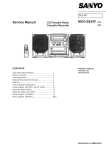
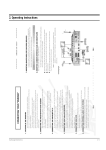
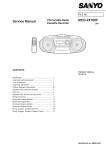
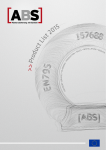
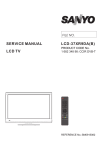
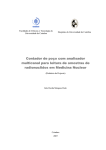
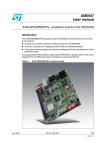
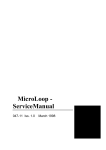


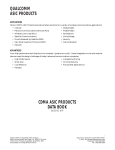
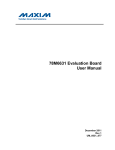



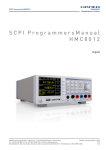
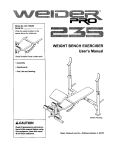
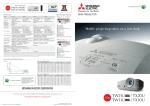

![2 Clique no botão [OK].](http://vs1.manualzilla.com/store/data/006043970_1-e2974f1cd0f0465d2cb4d13e53c48ce2-150x150.png)
